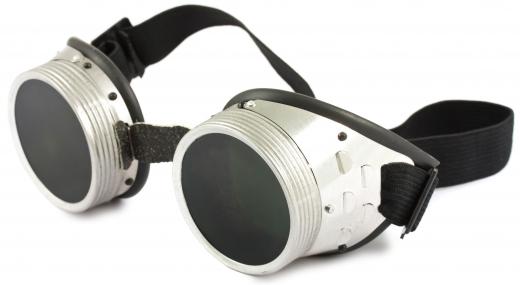At AboutMechanics, we're committed to delivering accurate, trustworthy information. Our expert-authored content is rigorously fact-checked and sourced from credible authorities. Discover how we uphold the highest standards in providing you with reliable knowledge.
What is Fusion Welding?
Fusion welding is the process used to in metalworking to join, or fuse, two pieces of metal by causing the metal to reach its melting point. The process requires the use of a filler metal, provided by the electrode or a wire, and a flux, which protects the molten metal of the weld from the damaging effects of the atmosphere. There are several types of fusion welding that are used for various applications. Common examples of this welding process include arc welding, electric resistance welding, oxy-fuel welding and thermite welding.
Arc welding is a form of fusion welding that uses electricity, supplied by a welding power supply, to produce an electric arc between an electrode and the pieces of metal to be joined. Arc welding is a popular choice in both industry and the home workshop because of its low initial costs and relatively low maintenance costs. The electrical arc of the arc welder is extremely focused, making automation of the welding process possible and earning a place for arc welding equipment on many assembly lines.

Similar to arc welding, electric resistance welding uses electricity to create the heat needed for welding. In an electric resistance welding setup, the electrodes rest on either side of the pieces to be welded together. Pressure is applied to push the two pieces together and create the electrical contact. This process is very limited in the size of material that can be worked with, and the cost of the equipment is often prohibitive for industrial applications.

Oxy-fuel welding is one of the best-known forms of fusion welding. This form of welding can incorporate a variety of fuel gases, including acetylene, liquid petroleum, hydrogen, propane, natural gas or propylene, but it requires the addition of oxygen to be considered oxy-fuel welding. The most common fuel gas choice is acetylene. Using acetylene gas and pure oxygen, oxy-fuel welding equipment can produce flame temperatures of 6,330 degrees Fahrenheit (3,500 degrees Celsius). This flame is hot enough to melt most industrial metals.

Thermite welding is another fusion welding process that uses intense heat and flame to bring the project metal to its melting point. Using iron oxide red and aluminum powder, thermite welding is capable of joining railroad rails. This powerful form of welding produces strong welds in a short amount of time. In the given example of joining railroad rails, the complete repair, including setup and finishing time, takes about one hour before a train can use the rail system.

Laser beam welding is a form of fusion welding that is sometimes used in manufacturing of automobiles and other mass-produced metal goods. Creating a very precise and concentrated source of heat, this welding process can penetrate deeply with a very narrow area being affected by the heat. Although this ability is preferable in many applications, the prohibitive costs of laser beam welding equipment leaves this form of welding largely relegated to a few major industries.
AS FEATURED ON:
AS FEATURED ON:














Discussion Comments
@blipham - These are the max temps for acetylene, propane and natural gas with oxygen:
Acetylene (c2h2) flame temperature with oxygen 5900of (3260oc)
Propane plus oxygen temperature 4579of (2526oc)
Natural gas flame temperature with oxygen 4600of (2538oc).
What is the maximum achievable temp for natural gas vs. acetylene?
I am a natural gas supplier. I was recently asked by a customer if natural gas could be used in his metal fusion process instead of acetylene. I know that natural burns much cooler than acetylene, but not sure how much. Could you compare the two using maximum achievable temps for each? Thanks
Post your comments